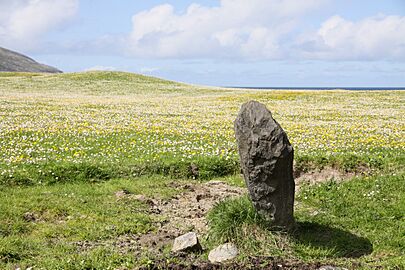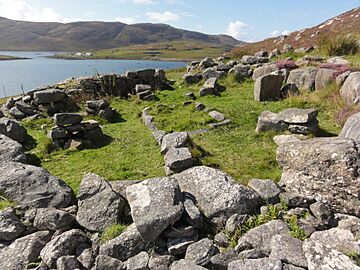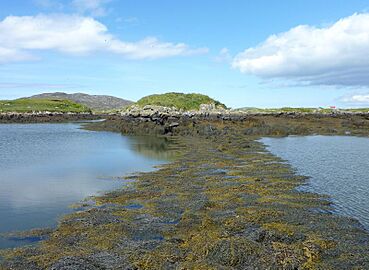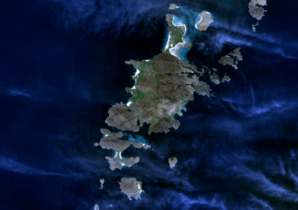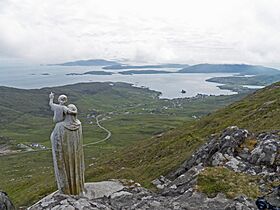Barra facts for kids
| Gaelic name | Eilean Bharraigh |
|---|---|
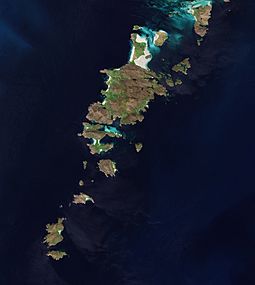 |
|
| OS grid reference | NF687004 |
| Coordinates | 56°59′00″N 7°28′00″W / 56.9833°N 7.4667°W |
| Physical geography | |
| Island group | Barra and Vatersay |
| Area | 5,875 ha (22.68 sq mi) |
| Area rank | 20 |
| Highest elevation | Heaval, 383 m (1,257 ft) |
| Administration | |
| Sovereign state | United Kingdom |
| Country | Scotland |
| Council area | Na h-Eileanan Siar |
| Demographics | |
| Population | 1,174 |
| Population density | 19.98 people/km2 |
| Largest settlement | Castlebay |
Barra is a beautiful island in the Outer Hebrides of Scotland. It's the second most southern island where people live, right after Vatersay. A special road called the Vatersay Causeway connects Barra to Vatersay.
In 2011, about 1,174 people lived on Barra. Both English and Scottish Gaelic are spoken widely here. In fact, in 2011, 62% of the people spoke Gaelic.
Contents
The Land of Barra
What is Barra made of?
Barra is made of some of the oldest rocks in Britain! These rocks are called Lewisian gneiss. They are incredibly ancient, formed billions of years ago. Some of these rocks have special minerals in them.
The island also has sandy areas, especially near the beaches. You can find peat in the northern parts of the island. Peat is a type of soil made from decayed plants.
How Big is Barra?
Barra is about 60 square kilometers (23 square miles) in size. It's about 18 kilometers (11 miles) long and 10 kilometers (6 miles) wide. A single road, the A888, goes around the coast in the southern part of the island. This road connects many small villages along the flat coastal areas.
The middle of the island is hilly and doesn't have many people living there. On the west and north sides, you'll find lovely white sandy beaches. These beaches are next to grassy areas called machair. The southeast side of Barra has many rocky areas. In the north, a sandy strip of land leads to the unique beach airport.
Barra's Past
Early Settlers
People have lived on Barra for a very long time! We know this because a pottery beaker from around 2500 BC was found. This was during the Neolithic era, also known as the New Stone Age. Many old stone remains, like a "work platform" and standing stones, have been found. There's even a large burial mound called a chambered cairn in the northern hills.
On nearby Vatersay, a Bronze Age cemetery and an Iron Age fort (called a broch) have been discovered. Another broch is on the east side of Barra. After storms in 2007, more Bronze Age burials and Iron Age roundhouses were found near Allasdale. People continued to live on Barra through the Iron Age, as shown by a special type of house called a wheelhouse.
Around the 800s, Viking settlers arrived. They gave the island the "ey" part of its name, which means "island" in Old Norse. The "Barr" part might come from a Gaelic name or an Old Norse word meaning "bare" or "rough." An old story says the first Viking to arrive was named Omund the Wooden-Leg.
The Kingdom of the Isles
The Vikings created the Kingdom of the Isles across the Hebrides, including Barra. This kingdom was connected to the King of Norway. Over time, a leader named Somerled made the kingdom independent. After he died, the kingdom was divided. A group called Clann Ruaidhrí ruled Barra and other islands.
In 1266, the Treaty of Perth officially gave the Kingdom of the Isles to Scotland. Scotland paid a lot of money for it! The treaty said that the local rulers could keep their power. So, the Clann Ruaidhrí lands became a special area called the Lordship of Garmoran. It was almost like its own small country within Scotland.
Lords and Chiefs
Later, the King of Scotland took control of the Lordship of Garmoran. In 1427, the island of Barra was given to Giolla Adhamhnáin Mac Néill, the Chief of Clan MacNeil.
The MacNeils made their home at Kisimul Castle. They became known for attacking English ships during the time of Queen Elizabeth I. King James VI of Scotland called the Chief, Roderick MacNeil, to explain. Roderick joked that he thought the King would be happy, since Queen Elizabeth had executed his mother, Mary, Queen of Scots! King James was amused and let him go.
Barra was mostly Catholic. During the Jacobite Uprising of 1745, the islanders faced threats. A Catholic priest named Father James Grant was even arrested and sent away, but he soon returned.
The MacNeil Chiefs owned Barra until 1838. Then, the island was sold to Colonel John Gordon. The Chief, Roderick MacNeil, had already left Kisimul Castle and built a new house. This led to debt, which was one reason he sold the island.
Colonel Gordon, like many new landowners, forced many islanders to leave their homes. This was part of the Highland Clearances, to make space for sheep farming. Some people moved to mainland Scotland. Others traveled far away to places like Australia, New Zealand, the United States, and Canada.
A famous Gaelic singer from Barra, Flora MacNeil, learned many songs from her mother's cousin, Mary Johnstone. Mary's parents had been forced to leave their home by Colonel Gordon's agents.
The worst evictions happened during the Highland Potato Famine in the 1840s. Many Barra residents were forced onto a ship called the Admiral and sent to Canada. It was a very difficult journey, and life was hard for them there.
The MacNeil Chiefs also moved away, first to Canada, then to the United States. But in 1937, Barra was bought back by Robert Lister Macneil, an American descendant. In 2000, his heir, Ian Roderick Macneil, leased Kisimul Castle to Historic Scotland for 1000 years. In 2003, he gave ownership of most of Barra to the Scottish Government. This means the people of Barra now have the right to take control of the land themselves if they wish.
In 2017, Barra got its own official flag! It has a white Nordic cross on a green background.
Fun Places to Visit
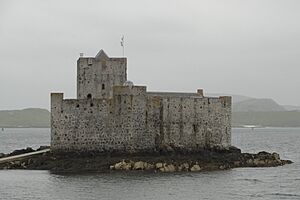
The main village on Barra is Castlebay. It's in a calm bay, and Kisimul Castle sits on a small island nearby. This castle gives the village its name! Castlebay is also the main harbor.
You can also find a smaller old tower house called Dun Mhic Leoid in the middle of Loch St Clare. This is on the west side of the island.
The highest point on Barra is Heaval. Near the top, there's a white marble statue called "Our Lady of the Sea." It shows the Madonna and Child and was put there in 1954. Many people on the island are Catholic, and the Catholic church in Castlebay is also dedicated to Our Lady of the Sea.
Other interesting places include a ruined church and museum at Cille Bharra. There are also several Iron Age forts (brochs) like Dùn Chuidhir and An Dùn Bàn. Many other ancient structures have been found and studied recently.
Barra is connected to the smaller island of Vatersay by a modern causeway. Vatersay has about 90 people living there.
-
A satellite photo showing Barra, Vatersay, and nearby islands.
Barra's Economy
How Barra Makes Money
Tourism is the main way people on Barra earn money. Many visitors come to the island from May to September. Thousands of people visit every year, especially during events like Fèis Bharraigh and BarraFest in July.
The Dualchas Heritage and Cultural Centre in Castlebay is a great place to learn about the island's history and culture. It has different exhibits each year. Travel guides often describe Barra as a "delightful little island with its own castle and beach airport." They suggest visiting the high cliffs, beautiful beaches, and bays.
The Outer Hebrides tourism website recommends seeing Kisimul Castle and the seals at Seal Bay. You can also visit the Barra Golf Club, the Heritage and Cultural Centre, and the churches. Tourism brings a lot of money to the Outer Hebrides and supports many jobs. Barra gets about 10% of the visitors to the Outer Hebrides.
Castlebay is the main place for tourists. It has hotels, a supermarket, a bank, and a petrol station. It's also a good starting point to visit other islands like the Uists and Benbecula.
In 2010, camping on the sandy areas near the airport was stopped because it was damaging the land. So, local farmers now offer places on their land for tourists to camp. You can also take boat trips to nearby Mingulay or even go island-hopping by plane!
Local Businesses
The Barratlantic factory in Northbay processes fish and shellfish. They sell king scallops, langoustines, and many types of white fish like cod, haddock, and monkfish. You can even buy fish directly from the factory!
The Hebridean Toffee Factory in Castlebay makes delicious toffee right on the island. You can order it from anywhere in the world!
Isle of Barra Distillers started in 2016. They make Barra Atlantic Gin, which has been very successful. They also plan to open the island's first single malt whisky distillery soon. Another distillery, Uisge Beatha nan Eilean Ltd, was founded in 2003.
To help the island's economy, there are wind turbines at Gòb Sgùrabhal. These turbines produce electricity and aim to use local materials and workers as much as possible.
Barra in Media
Movies and TV Shows
Barra has been featured in many movies and TV shows! A local TV company, Little Day Productions, made a documentary called Barra to Barcelona. It was shown on BBC Alba, the Scottish Gaelic TV channel.
The famous 1949 comedy movie Whisky Galore! was filmed on Barra. This movie is based on a true story about a ship that ran aground with lots of whisky on board in 1941. The author of the book, Sir Compton Mackenzie, lived near the airport and is buried in the Cille Bharra cemetery. The sequel, Rockets Galore!, was also filmed here.
In the old TV show Dad's Army, a character named Private Frazer often said he was from Barra, calling it "a wild and lonely place."
Barra was also featured on Time Team, where archaeologists dug up several Iron Age sites. In 2006, a documentary called Extraordinary People: The Boy Who Lived Before featured a boy who claimed to remember a past life on Barra.
The BBC Two documentary An Island Parish filmed its fifth and sixth series on Barra. It showed the experiences of a new Catholic priest on the island.
Books
A Franciscan priest and author named Rayner Torkington wrote a book called Peter Calvay, Hermit. It describes how he was inspired by meeting a hermit who lived on a nearby island called Hellisay. Torkington's other book, Wisdom from the Western Isles, also talks about his time on Barra.
Other Media
In 2008, the Barra RNLI Life Boat, called Edna Windsor, was featured on a series of stamps! One stamp showed the lifeboat in action near Barra.
Sports and Fun
Barra hosts an annual half-marathon called the Barrathon. It's part of a series of races in the Western Isles. There's also a shorter fun-run for families and younger children. Many events, like ceilidhs (traditional Scottish gatherings with music and dancing), happen around this time.
There's also an annual hill race where people run up Heaval, the island's highest point, and back to Castlebay Square. The fastest time recorded is just over 26 minutes!
The Barra community also holds annual Highland Games. The island's golf club, Comunn Goilf Bharraidh, has a 9-hole course. Some say it's the most western golf course in the United Kingdom!
Visitors can also try sea kayaking, power kiting, and fishing. You can even go pony trekking on the rare Eriskay Ponies!
Getting Around Barra
By Air
Barra has a very special airport near Northbay. It uses the large cockle shell beach called Traigh Mhor as its runway! Planes can only land and take off when the tide is low, so the flight schedule changes daily. Barra's airport is famous for being the only airport in the world with regular flights landing on a beach.
As of 2019, Loganair flies to Barra from Glasgow using small Twin Otter planes. There are usually flights every day in the summer.
By Sea
A large car ferry travels between Castlebay on Barra and Oban on the mainland. This trip takes about five hours. A smaller car ferry connects Barra to South Uist. It travels between Ardmore in the north of Barra and Ceann a' Gharaidh in Eriskay. This shorter trip takes about 40 minutes. Both ferries are run by Caledonian MacBrayne.
On the Island
There are local buses on Barra. They use the circular A888 road and the road to the northern ferry terminal and the airport. The bus times usually match the flight and ferry schedules.
Barra and Vatersay Community
Coimhearsachd Bharraidh agus Bhatarsaidh (Barra and Vatersay Community) Ltd is a company owned by the community. Its goal is to help develop Barra and Vatersay. It's run by volunteers who live on the islands.
One of their projects is a large wind turbine at Gòb Sgùrabhal, on the northwest tip of the island. This turbine is expected to produce a lot of clean energy for the community.
Weather in Barra
Barra has an oceanic climate, which means it has mild temperatures all year round.
| Climate data for Barra (Traigh Mhòr Airport, 0 m asl, averages 1991–2020) | |||||||||||||
|---|---|---|---|---|---|---|---|---|---|---|---|---|---|
| Month | Jan | Feb | Mar | Apr | May | Jun | Jul | Aug | Sep | Oct | Nov | Dec | Year |
| Mean daily maximum °C (°F) | 8.6 (47.5) |
8.2 (46.8) |
9.2 (48.6) |
10.7 (51.3) |
13.1 (55.6) |
14.9 (58.8) |
16.4 (61.5) |
16.6 (61.9) |
15.1 (59.2) |
12.6 (54.7) |
10.4 (50.7) |
8.8 (47.8) |
12.1 (53.8) |
| Mean daily minimum °C (°F) | 4.6 (40.3) |
4.3 (39.7) |
4.7 (40.5) |
6.1 (43.0) |
7.8 (46.0) |
10.0 (50.0) |
11.7 (53.1) |
12.1 (53.8) |
11.0 (51.8) |
8.8 (47.8) |
6.5 (43.7) |
4.9 (40.8) |
7.7 (45.9) |
| Average rainfall mm (inches) | 143.5 (5.65) |
101.7 (4.00) |
99.0 (3.90) |
70.2 (2.76) |
55.2 (2.17) |
67.1 (2.64) |
78.3 (3.08) |
93.7 (3.69) |
93.2 (3.67) |
112.7 (4.44) |
125.2 (4.93) |
135.9 (5.35) |
1,175.7 (46.29) |
| Average rainy days (≥ 1 mm) | 22.5 | 18.8 | 18.4 | 13.9 | 12.9 | 12.8 | 14.8 | 17.4 | 16.5 | 20.3 | 22.0 | 21.7 | 212.0 |
| Mean monthly sunshine hours | 27.2 | 63.2 | 105.5 | 163.0 | 211.8 | 177.3 | 160.6 | 158.7 | 118.6 | 84.8 | 42.8 | 19.5 | 1,333.1 |
| Source: Met Office | |||||||||||||
Famous People from Barra
- Angus MacNeil (born 1970), a Member of Parliament for the area.
- Flora MacNeil (1928—2015), a famous Scottish Gaelic singer from Barra.
- Mick MacNeil (born 1958), a keyboardist for the band Simple Minds from 1978 to 1990.
See also
 In Spanish: Barra (Escocia) para niños
In Spanish: Barra (Escocia) para niños




